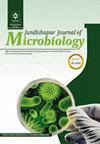动物白色念珠菌临床分离株微卫星长度多态性分析
IF 0.5
4区 医学
Q4 MICROBIOLOGY
引用次数: 0
摘要
背景:白色念珠菌是从不同动物身上采集的最常见的念珠菌。目的:本研究旨在利用微卫星长度多态性(MLP)评价从念珠菌感染动物临床标本中分离的白色念珠菌的遗传多样性和遗传关系。方法:我们使用MLP对从不同动物物种(狗:16,猫:10,马:10,牛:14,鸡:10)分离的60株白色念珠菌菌株进行研究,这些菌株以前被定义为动物临床分离株。扩增三个基因座,包括EF3、CDC3和HIS3,并将产物运到ABI XL 370遗传分析仪上,测定片段大小。结果:在所示的60株临床菌株中,鉴定出49种不同的基因型,判别力指数为0.991。共鉴定出EF3基因座的17个等位基因和26个不同的组合,CDC3基因座的6个等位突变和13个组合,HIS3基因座的7个等位变异和27个组合。最常见的基因型是GP9(4株)和GP1和GP33(3株)。计算Wright固定指数(FST)值,以评估从不同动物宿主分离的白色念珠菌五个亚群的所有成对组合的组间遗传多样性。从鸡分离的白色念珠菌的最高FST值与猫(FST:0.1397)、牛(FST:0.0639)和马(FST:0.0585)三个亚群有关。本文章由计算机程序翻译,如有差异,请以英文原文为准。
Analysis of Microsatellite Length Polymorphism for Clinical Isolates of Candida albicans from Animals
Background: Candida albicans has been shown as the most common species of Candida collected from different animals. Objectives: This study aimed to evaluate the genetic diversity and genetic relationships among C. albicans isolates collected from clinical specimens of animals suffering from candidiasis using microsatellite length polymorphism (MLP). Methods: We used MLP for a group of 60 C. albicans strains isolated from various animal species (dog: 16, cat: 10, horse: 10, cow: 14, chicken: 10), previously defined as animal clinical isolates. Three loci, including EF3, CDC3, and HIS3, were amplified, and the products ran onto an ABI XL 370 genetic analyzer, and fragment sizes were determined. Results: Of the 60 clinical strains illustrated, 49 different genotypes were identified with a discriminatory power index of 0.991. A total of 17 alleles and 26 different combinations were identified for EF3 locus, six alleles and 13 combinations for CDC3 locus, and 17 alleles and 27 combinations for HIS3 locus. The most common genotypes were GP9 (four strains) and GP1 and GP33 (three strains). Wright’s fixation index (FST) values were calculated to assess inter-group genetic diversity for all pairwise combinations of the five sub-populations of C. albicans isolated from the different animal hosts. The highest FST values related to C. albicans isolated from chicken to three sub-populations of cats (FST: 0.1397), cows (FST: 0.0639), and horses (FST: 0.0585). Conclusions: The results indicated a moderate genetic differentiation (0.05 < FST < 0.15) between C. albicans strains isolated from cats, cows, and horses as a mammal vs. chickens.
求助全文
通过发布文献求助,成功后即可免费获取论文全文。
去求助
来源期刊

Jundishapur Journal of Microbiology
MICROBIOLOGY-
CiteScore
1.30
自引率
0.00%
发文量
56
审稿时长
6-12 weeks
期刊介绍:
Jundishapur Journal of Microbiology, (JJM) is the official scientific Monthly publication of Ahvaz Jundishapur University of Medical Sciences. JJM is dedicated to the publication of manuscripts on topics concerning all aspects of microbiology. The topics include medical, veterinary and environmental microbiology, molecular investigations and infectious diseases. Aspects of immunology and epidemiology of infectious diseases are also considered.
 求助内容:
求助内容: 应助结果提醒方式:
应助结果提醒方式:


